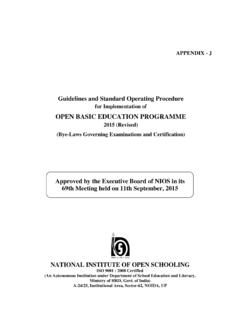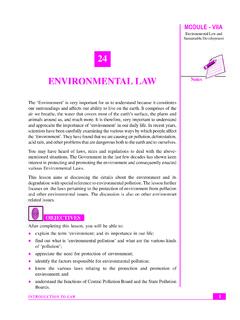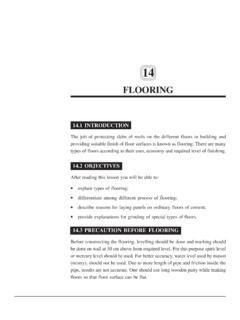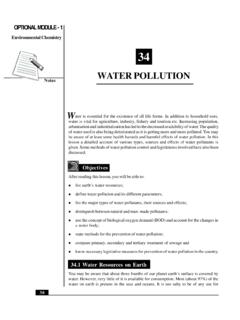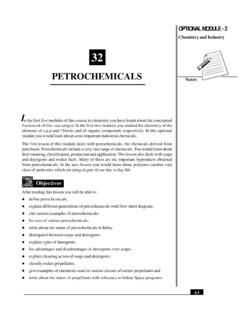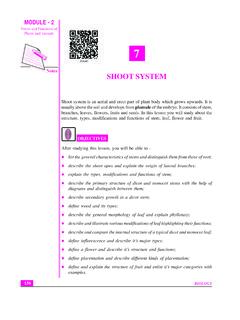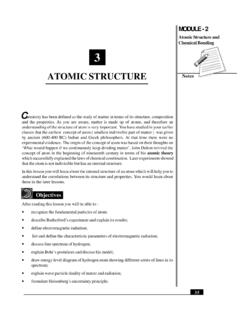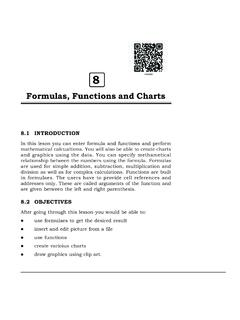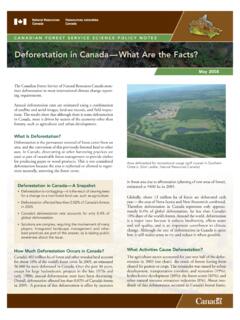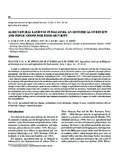Transcription of Notes LAND, SOIL AND VEGETATION RESOURCES IN INDIA
1 MODULE - 7 Natural resource and theirdevelopment in INDIA 87 land , soil and VEGETATION RESOURCES in IndiaNotesGEOGRAPHY20 land , soil AND VEGETATIONRESOURCES IN INDIAThe nation s strength, be it social, economic or political depends mostly on theavailable RESOURCES and their proper utilisation. But what is a resource ? In simplerterms, resource is the matter or substance which satisfies human wants at a giventime and space. Before any element can be designated as resource three basicpre-conditions must be satisfied. They are the knowledge, technical skills anddemand for the material or services produced. If one of these conditions is notsatisfied the particular substance remains unutilised. Let us explain it through oneexample. From time immemorial, water is present on the earth. But it becomes asource of energy when people gained the knowledge and technical skills forhydel power generation.
2 It is therefore human ability and need which createresource value and not their sheer physical presence. So the basic concept ofresource is also related to human has rich endowment of RESOURCES . An integrated effort is now being madeby our country to make the best use of the existing resource potential. It helps tomeet the demands of growing population and also provide opportunities foremployment. Simultaneously, it acts as indicator for the levels of development. Inthis lesson we will study three vital RESOURCES land , soil and studying this lesson, you will be able to : recognise the significance of land as a resource ; identify the main uses of land ; explain some of the problems in land resource and their solutions; recognise the significance of soil as a resource ; . recall the main characteristics of each major soil type in INDIA ;MODULE - 7 88 land , soil and VEGETATION RESOURCES in IndiaNatural resource and theirdevelopment in IndiaNotesGEOGRAPHY locate major soil regions on the map of INDIA ; identify different factors that are responsible for the soil erosion in differentparts of INDIA ; explain the problems created as a result of soil erosion; establish the relationship between measures adopted for soil conservationwith types of erosion in different parts of INDIA .
3 Identify major constituents of VEGETATION ; recognise major VEGETATION types; land RESOURCELand is our basic resource . Throughout history, we have drawn most of oursustenance and much of our fuel, clothing and shelter from the land . It is useful tous as a source of food, as a place to live, work and play. It has different roles. Itis a productive economic factor in agriculture, forestry, grazing, fishing and is considered as a foundation for social prestige and is the basis of wealth andpolitical power. It has many physical forms like mountains, hills, plains, lowlandsand valleys. It is characterised by climate from hot to cold and from humid todry. Similarly, land supports many kinds of VEGETATION . In a wider sense, landincludes soil and topography along with the physical features of a given is in this context that land is identified closely with natural environment.
4 However,it is also regarded as space, situation, factor of production in economic processes,consumption goods, property and of Arable LandIndia is well endowed with cultivable land which has long been a key factor inthe country s socio-economic development. In terms of area, INDIA ranks seventhin the world, while in terms of population it ranks second. Arable land includesnet sown area, current fallow, other fallow and land under tree crops. Arableland covers a total area of 167 million hectares which is 51 % of the total area ofthe , the arable land -man ratio is not as favourable as in many other countrieslike Australia, Canada, Argentina, the USA, Chile, Denmark and , the land -man ratio is more favourable in INDIA than Japan, theNetherlands, Egypt, United Kingdom, Israel and China. What is the land -manratio? land -man ratio is defined as the ratio between the habitable area and thetotal population of a physical features in INDIA are diverse and complex.
5 There are mountains,hills, plateaus and plains which produce varied human response to the use ofland RESOURCES . About 30% of INDIA s surface area is covered by hills andmountains. These are either too steep or too cold for cultivation. About 25% ofthis land is topographically usable which is scattered across the country. PlateausMODULE - 7 Natural resource and theirdevelopment in INDIA 89 land , soil and VEGETATION RESOURCES in IndiaNotesGEOGRAPHY constitute 28% of the total surface area but only a quarter of this is fit for plains cover 43% of the total area and nearly 95% of it is suitable for the differences in proportion of surface area, this allows us to concludethat taking the country as a whole, about two-third of it is usable. Moreover, soils,topography, moisture and temperature determine the limits of cultivability and thequality of arable land is determined by these factors.
6 As a result of this, half of thesurface area is cultivated. This proportion is one of the highest in the world. land includes both soil and topography with the physical features of agiven location. It is also regarded as space, factor of production ineconomic processes, consumption goods, situation, property and capital. land -man ratio is defined as the ratio between the habitable area andthe total population of a country. land -man ratio in INDIA is not as favourable as in many countries likeAustralia, Canada, Argentina, USA, Chile, Denmark and , the land -man ratio is more favourable in INDIA than in Japan,the Netherlands, Egypt, , Israel and QUESTIONS land -man four countries where land -man ratio is much more favourable than inIndia.(i)_____(ii)_____ (iii)_____ (iv) four countries where land -man ratio is less favourable than in INDIA .
7 (i)_____(ii)_____ (iii)_____ (iv) land USEOut of the total geographical area (328 million hectares), land utilisation statisticsare available for 305 million hectares only. The balance 23 million hectares remainsunsurveyed and inaccessible. The relevant statistic are given in Table Thesignificant features of land utilisation are :(a)high percentage of area suitable for cultivation;(b)limited scope for further extension of cultivation and(c)small area under pastures despite a large bovine - 7 90 land , soil and VEGETATION RESOURCES in IndiaNatural resource and theirdevelopment in IndiaNotesGEOGRAPHYT able land Utilisation in IndiaCategoryArea in M. Ha% of total reporting sown and available for Cultivation(a) Barren and uncultivable (b) land under non-arable land utilisation in IndiaPresently, a little more than 40 million hectares of land is not available for under this category has shown a decline from million hectares in 1960-61 to million hectares in 1990-91.
8 There has been a marginal decline infallow land from in 1950-51 to in 1990-91. Cultivable wastelandsalso witnessed an appreciable decline of 34% between 1950-51 and 1950-51 and 1990-91, the net sown area has witnessed notable increaseof about 20%. This area in 1950-51 was million hectares which increasedMODULE - 7 Natural resource and theirdevelopment in INDIA 91 land , soil and VEGETATION RESOURCES in IndiaNotesGEOGRAPHYto million hectares in 1990-91. Only 14% of the net sown area or hectares produced two or more crops in 90-91. Surprisingly, only 5% ofthe land is under permanent pastures and grazing in a country with the largestbovine population of the world. land under non-agricultural use has increasedwith the accelerated growth in economy. The process of industrialisation andurbanisation demands more land under roads, railways, airports, human settlementsand industries not excluding huge multi-purpose dams.
9 Essentially, on the limitedtotal area all the cultural uses of land must be accommodated. Obviously, it can berealised mainly at the cost of land under agriculture. In 1950-51, the total areaunder non-agricultural use was million hectares which increased to millionhectares in 1990-91. Contrary to general belief, the percentage of land underforest is one of the lowest in the world. Forests occupy not more than 22% of thetotal geographical area of the country, while the world average is 30%. Accordingto land use statistics, area under forests has increased from 40 million hectares in1950-51 to 68 million hectares in 1990-91. It is much below the desired nationalgoal of one third of the total , land use is a dynamic process. It changes over time due to a number offactors, including increasing population, changes in cropping system and the various sectors of the economy develop, there may be a shift in the patternof land use.
10 However, the bulk of the land continues to be used for raising unabated population growth, the pressure of population on arable land isbound to grow. Indeed, it should be a matter of great national land PROBLEMSOut of the total land area, as many as 175 million hectares suffer from degradation is caused largely by soil erosion, but also by water logging andexcessive salinity. The most serious threat to the soil is posed by railfall during monsoon damages the soils. Steep slopes encourage rapidrunoff leading to soil erosion especially on the southern slopes of the Himalayasand the western slopes of the Western Ghats. Major portions of the Himalayasare prone to landslides and erosion. Wind erosion is prevalent in Rajasthan, gullyerosion in Chambal Valley, Chotanagpur, Gujarat, Submontane Punjab logging and salinisation which constitute the second major threat to soilhave already consumed 13 million hectares and threaten many more.
